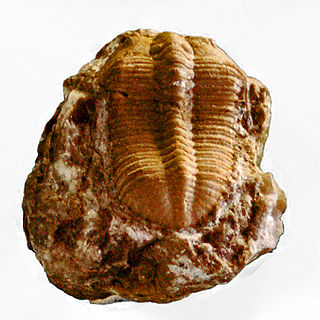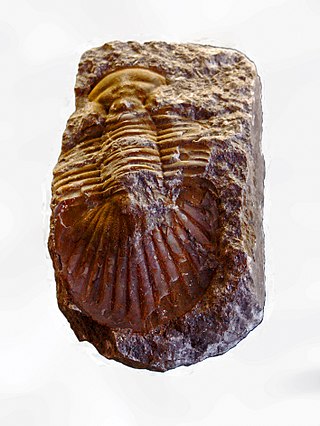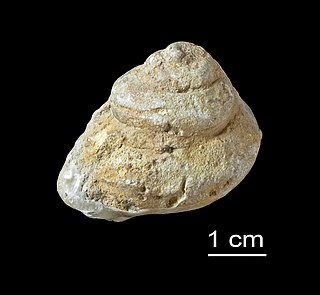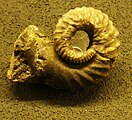Joseph John Sepkoski Jr. was a University of Chicago paleontologist. Sepkoski studied the fossil record and the diversity of life on Earth. Sepkoski and David Raup produced a new understanding of extinction events, by developing a statistical approach to the study of taxonomic diversification. He suggested that the extinction of dinosaurs 66 mya was part of a cycle of mass extinctions that may have occurred every 26 million years. But his most important contribution was the identification of the "Big 5" mass extinctions, events that have shaped the evolution of life on earth.
Zooceras is an extinct genus of prehistoric nautiloids known from Pragian-aged fossils in the Prague Basin. The fossils were originally described by Joachim Barrande as species of Cyrtoceras. The shells are curved into a "C" shape.
Arionoceras is an extinct orthocerid genus from the Middle and Upper Silurian, of Europe that is estimated to have lived from 422.9 to 418.1 mya, existing for approximately 4.8 million years.
Cryptocycloceras is an extinct genus of actively mobile carnivorous cephalopod that lived in what would be Europe during the Silurian from 422.9—418.7 mya, existing for approximately 4.2 million years.
Donacoceras is an extinct genus of actively mobile carnivorous cephalopod, essentially a Nautiloid that lived in what would be North America during the Ordovician from 460.5—443.7 mya, existing for approximately 16.8 million years.
Neosichuanoceras is an extinct genus of actively mobile carnivorous cephalopod, essentially a Nautiloid, that lived in what would be Asia during the Silurian from 436.0 to 428.2 mya, existing for approximately 7.8 million years.
Orthocycloceras is an extinct genus of actively mobile carnivorous cephalopods, essentially a Nautiloid, that lived in what would be Europe during the Silurian to Devonian from 428.2 to 412.3 mya, existing for approximately 15.9 million years.
Vericeras is an extinct genus of nautiloid cephalopod that lived in what would be Europe during the Silurian from 421—418.7 mya, existing for approximately 2.3 million years.

Pachydesmoceras is a genus of ammonites belonging to the family Desmoceratidae.

Hercoceras is a genus of trochoidally coiled nautiloid cephalopods placed in the nautilid family Rutoceratidae. These cephalopod lived i in the Eifelian age of the middle Devonian Period, which occurred 398-391 million years ago. Their shells have prominent lateral outgrowths in the form of spines and a high intraspecific variability.

Metacalymene is a genus of trilobites in the order Phacopida, family Calymenidae. This genus is considered monotypic, containing only the type species:

Bojoscutellum is a genus of trilobites in the order Corynexochida family Styginidae.

Crotalocrinites, also known as the feather star, is a genus of extinct sea lily belonging to the family Crotalocrinitidae. These feather stars were stationary intermediate-level organisms feeding on suspension epifauna. They lived in the Silurian period, from the Upper Wenlock age to the Ludlow age.

Inversoceras is a genus of cephalopods in the order Oncocerida and the family Trimeroceratidae. These mollusks were fast-moving nektobenthic carnivores. They lived in the Silurian period, from the Lower Wenlock age to the Ludlow age.

Requienia is an extinct genus of fossil saltwater clam, a marine bivalve molluscs in the order Hippuritida, family Requieniidae. These rudists lived in the Cretaceous period, from the Valanginian age (136.4–140.2) to the Campanian age. They were stationary intermediate-level suspension feeders.

Belemnites is a genus of an extinct group of cephalopods belonging to the order Belemnitida. These cephalopods existed in the Early Jurassic period from the Hettangian age to the Toarcian age (175.6–183.0). They were fast-moving nektonic carnivores.

Lopha is a genus of marine bivalve molluscs in the family Ostreidae.

Holopea is an extinct genus of fossil sea snails, Paleozoic gastropod mollusks in the family Holopeidae.

Lopha marshii is a fossil species of true oyster, a marine bivalve mollusc in the family Ostreidae, the true oysters. This species was present in the Bajocian age.

Pictonia is an extinct ammonoid cephalopod genus belonging to the family Aulacostephanidae. These fast-moving nektonic carnivores lived during the Jurassic period, Kimmeridgian age.













